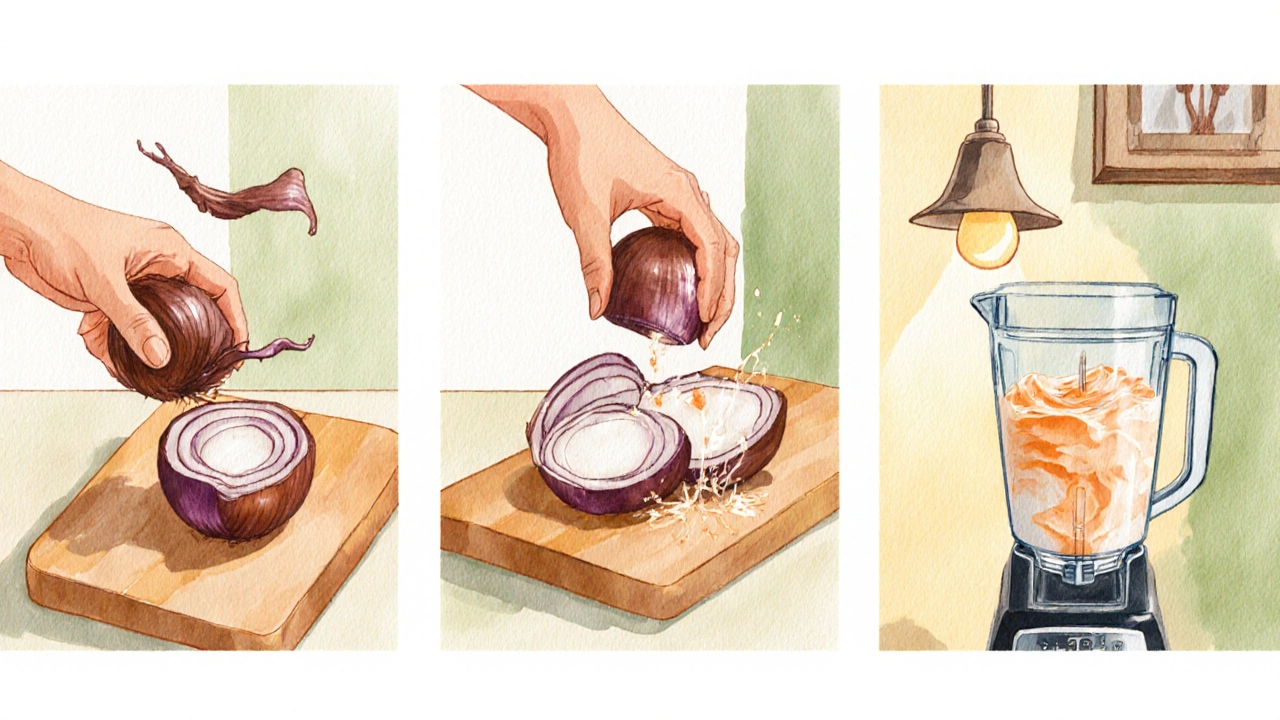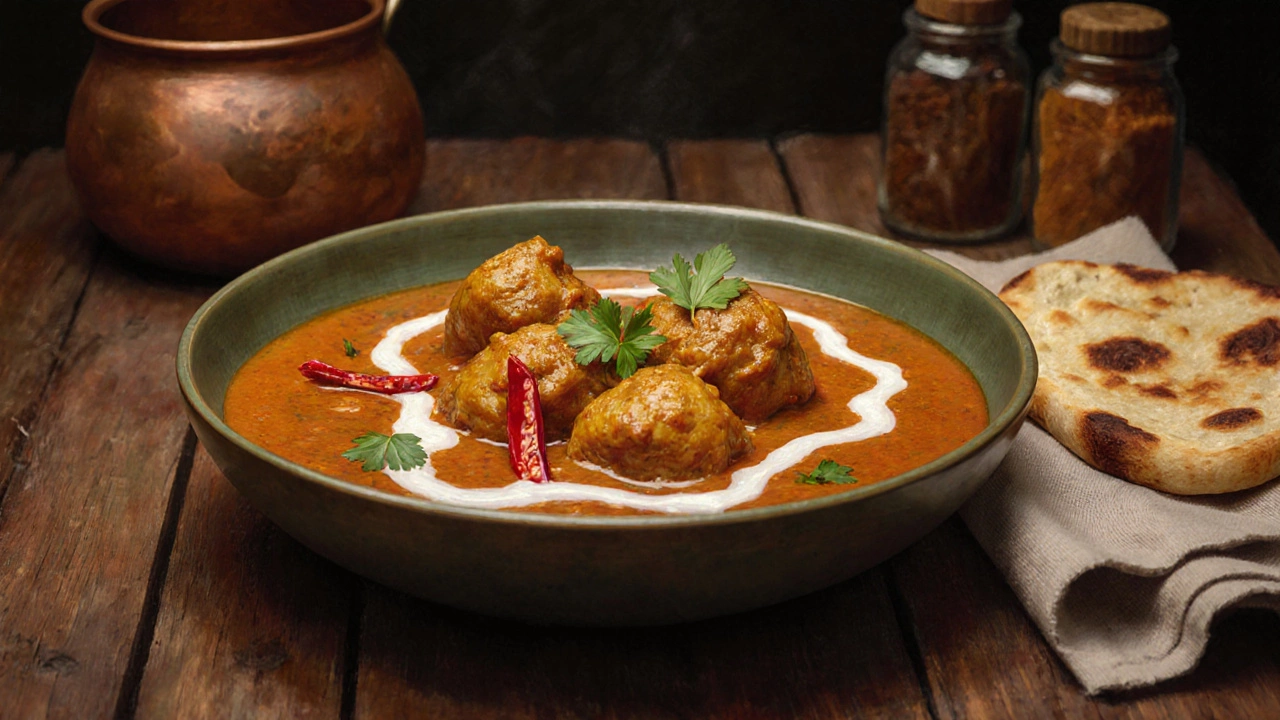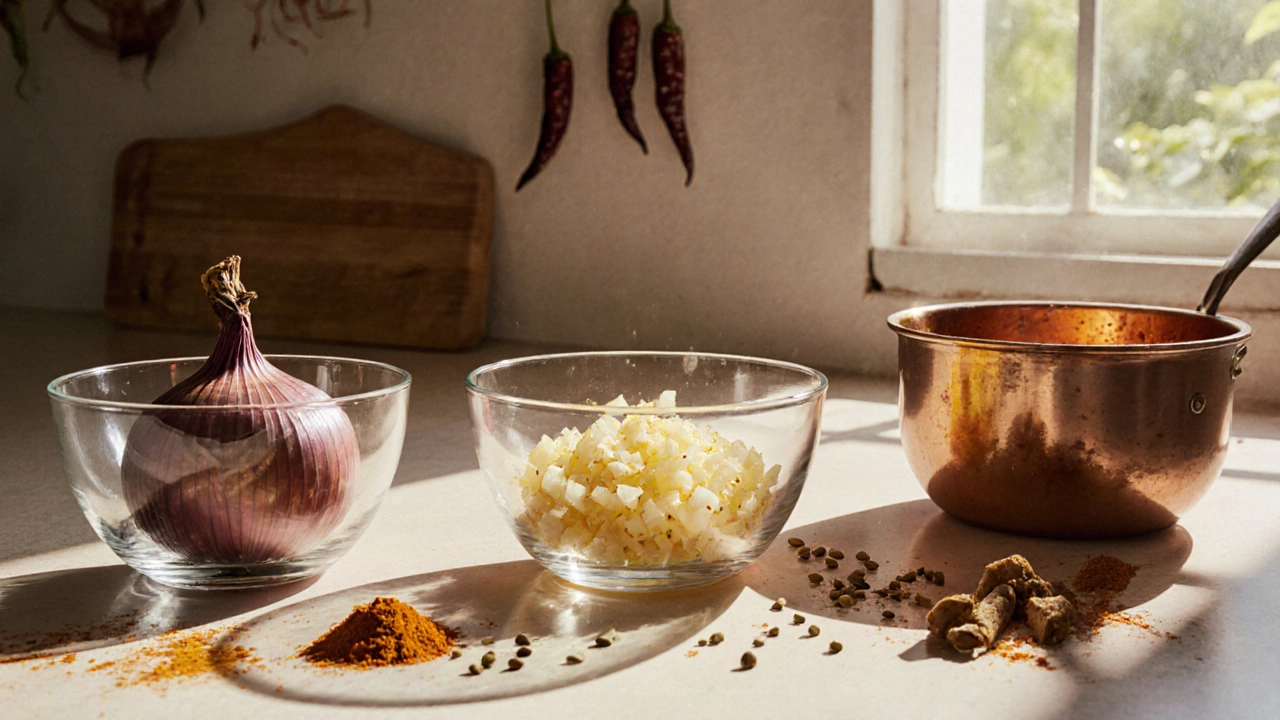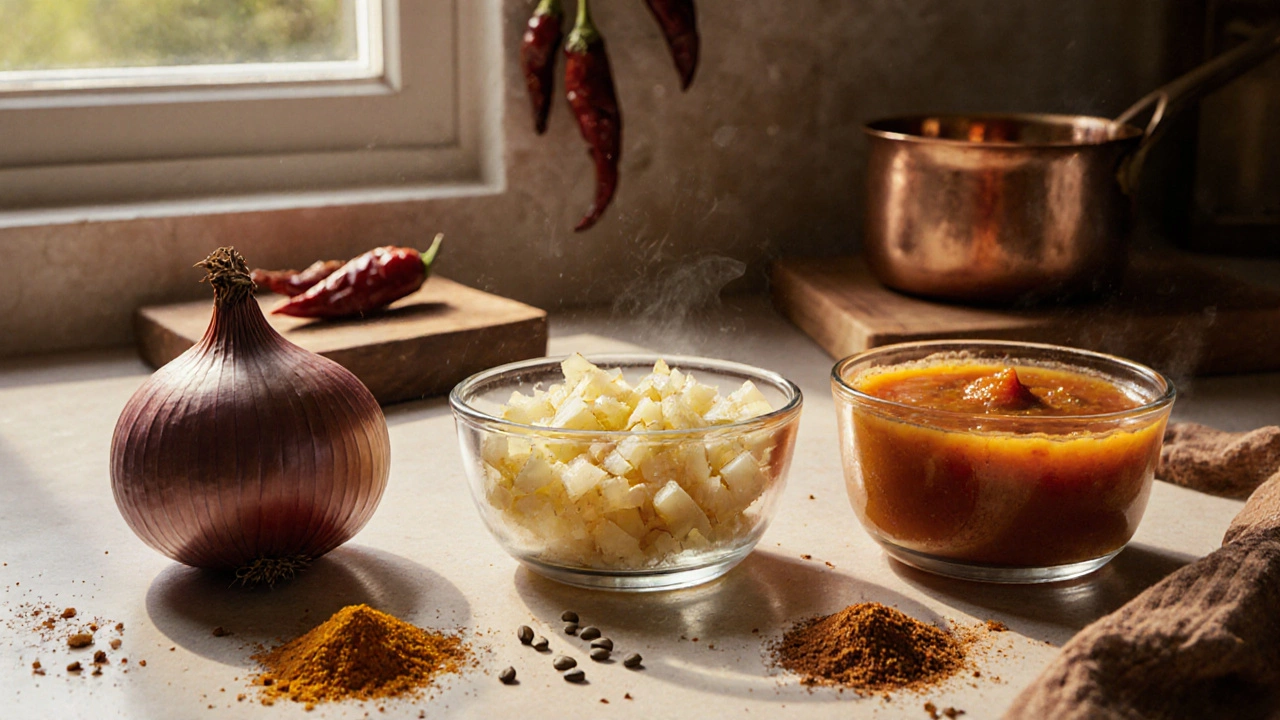Onion Texture Decision Guide
Curry Style Assessment
Select your situation to determine whether blending onions is the right choice for your chicken curry.
✓ Recommended Method
When you blend onions for a chicken curry, the first decision is whether the Onion a bulb vegetable that adds sweetness, aroma, and body to sauces should stay whole, be diced, or be turned into a smooth puree. This choice changes the dish’s texture, cooking speed, and flavor depth. Below we break down the pros and cons, walk through the perfect blending technique, and give you a quick decision checklist so you never wonder “should I blend onions?” again.
Why onion texture matters in a chicken curry
The base of most Indian curries is a Curry a stew-like dish flavored with spices, herbs, and often a blend of onions, tomatoes, and dairy or coconut milk. Onions provide three key things:
- Sweetness that balances heat.
- Body that gives the sauce a luxurious mouthfeel.
- Aroma that forms the aromatic foundation with garlic, ginger, and spices.
If you chop the onion into pieces, you’ll get distinct bites and a slightly crunchy texture. If you blend it into a puree, the sweetness integrates fully, and the sauce becomes silky. The decision hinges on the style of curry you aim for and the time you have.
Whole onions vs blended onion puree: a side‑by‑side look
| Aspect | Whole / diced onions | Blended onion puree |
|---|---|---|
| Texture in sauce | Visible pieces, slight crunch if not over‑cooked | Velvety, no visible bits |
| Cooking time | 8‑10minutes to soften, longer to caramelize | 3‑4minutes; puree cooks quickly |
| Flavor integration | Layered - sweet notes emerge gradually | Immediate, uniform sweetness throughout |
| Color | Golden‑brown when caramelized | Deep amber, smoother hue |
| Best for | Chunky curries, rustic dishes, slow‑cooked stews | Silky sauces, quick week‑night curries, restaurant‑style presentation |
Notice how the puree shortens the cooking window. That’s a huge win for busy evenings, but you lose the tiny caramelized bits that add depth in a traditional slow‑cooked curry.

When to blend onions for chicken curry
Here are three common scenarios where blending shines:
- Time crunch. If you’re making dinner after work, pureeing the onion cuts the sauté step in half.
- Desired silkiness. When you serve the curry with naan or rice, a smooth sauce feels more elegant.
- Even flavor distribution. For milder palates-children, for example-pureed onions prevent occasional bites that feel too strong.
Conversely, avoid blending if you love the caramelized onion crunch or are preparing a Chicken the lean protein that forms the heart of many Indian curries stew that simmers for an hour or more. The longer cook will naturally break down the pieces.
How to blend onions properly
Follow this simple, fool‑proof method to get a perfect puree every time:
- Peel and quarter. Remove the papery skin, cut the onion into four wedges.
- Rinse quickly. A brief cold water rinse removes the sting without washing away flavor.
- Dry well. Pat the wedges with a kitchen towel; excess water can make the puree watery.
- Blend with a splash of liquid. Add 2‑3tablespoons of water, broth, or coconut milk (Coconut milk a creamy liquid extracted from grated coconut flesh) to help the blades move.
- Pulse, don’t puree. Pulse 5‑6 times until you see a coarse paste, then blend a few more seconds for smoothness. Over‑blending can release too much sulfur, making the taste bitter.
- Season lightly. Sprinkle a pinch of salt now; it helps draw out moisture and reduces any sharp onion bite.
Tip: If you don’t have a high‑speed blender, a food processor or even a hand‑held immersion blender works fine. Just keep the vessel closed to avoid splatter.

Common pitfalls and how to avoid them
- Too much water. Adding more than a tablespoon per onion can turn the base soupy. Use a measuring spoon, not a free‑pour.
- Burning the puree. Pureed onions cook faster, so keep the heat medium‑low and stir constantly. They can go from golden to burnt in seconds.
- Over‑seasoning early. Salt draws out moisture, but adding heavy spices (like garam masala) too soon can make the flavor lock in before the onions soften. Add the main spice blend later, after the puree has cooked for a couple of minutes.
Speaking of spice blends, the classic Garam masala a warm Indian spice mix typically containing cinnamon, cardamom, cloves, cumin, and coriander is best introduced after the onion puree has turned a deep amber. This prevents the delicate aromatics from evaporating.
Flavor balance tips for a perfect chicken curry
Even with the perfect onion base, a chicken curry needs harmony. Keep these ratios in mind:
- Acid. A splash (½cup) of tomato puree (Tomato a fruit used as a base for sauces, providing tanginess and color) balances the sweet onion.
- Heat. Green chilies or a pinch of cayenne give a gentle kick without overpowering the onion sweetness.
- Freshness. Add finely chopped Garlic a pungent bulb used for flavoring and Ginger a spicy root that adds warmth and brightens the palate toward the end of cooking to retain their zing.
- Richness. Finish with a drizzle of coconut milk or a knob of butter for a glossy finish.
When you blend the onions, you’ll notice that the sauce feels smoother, and the flavors meld faster. That’s why many restaurants prefer the puree method for consistency.

Quick checklist before you start
- Onions peeled, quartered, and dried?
- Blender or food processor ready, with a splash of water or coconut milk?
- Chicken pieces trimmed and seasoned?
- All spices measured (garam masala, turmeric, coriander powder)?
- Tomato puree, garlic, ginger, and optional chilies on hand?
- Medium‑low heat set for the onion puree stage?
Cross these off, and you’ll glide through the cooking process without second‑guessing the onion step.
Frequently Asked Questions
Should I season the onion puree before cooking?
A light pinch of salt is enough. It draws out moisture and softens the raw edge. Save the main spice blend for after the puree turns a rich amber.
Can I use a food processor instead of a blender?
Yes. A food processor gives a slightly coarser texture, which some people prefer. Just be sure to pulse rather than run continuously to avoid overheating.
Will blended onions make the curry too sweet?
If you add too much onion or over‑cook the puree, the sweetness can dominate. Balance it with acidity (tomato or a splash of lemon) and a touch of heat.
Is it okay to blend raw onions for a curry that simmers for an hour?
Absolutely. Long simmering will break down the puree even further, giving a velvety sauce. Just keep an eye on the heat to prevent burning.
What’s the best liquid to add while blending?
Water works, but a splash of coconut milk adds richness and ties the flavor profile of many Indian chicken curries together.
